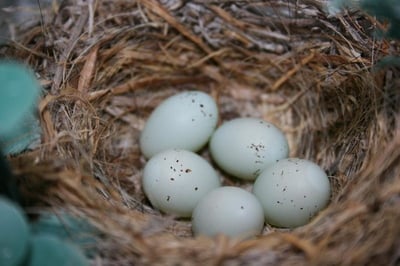 A note on the photos in this article: These photos are from the internet, but the usage is tagged as: “free to share, use, or modify even commercially”
A note on the photos in this article: These photos are from the internet, but the usage is tagged as: “free to share, use, or modify even commercially”
Plastic easter eggs, and egg coloring decorations, are usually brightly colored, but what about birds’ eggs in the wild? Why are some eggs speckled while others are brightly colored? In this article, we will explore the science behind egg coloration with a focus on three birds that live in the area and the coloration of their eggs.
The two factors influencing egg coloration are how the sun affects the egg, and the ability for eggs to camouflage in the nest. How darkly (or lightly) colored an egg is impacts the amount of light that reaches its interior, as well as how much light is absorbed. David Lahti and Dan Arida, researchers from the City University of New York and Franklin & Marshall College, tested a hypothesis that pigmentation helps strike a balance between those two factors. They found that darker colored eggs shielded the egg’s interior from light, but also caused higher internal temperatures which can be very damaging in brightly colored environments. Overheating can speed up embryonic development. They labeled this the "pigment as parasol" effect.
One example of a bird that lives in the area with darker colored eggs is the classic American Robin. Robins have nests with distinctly blue, or blue green, eggs which are distinctively unmarked, and the eggs are found in moderately bright environments such as forests, prairies, or outside human made structures like gutters and lights. These darker colors protect the egg from UV light.
Lighter eggs are usually found in brighter environments, less protected from the sun. They avoid the “dark car” effect that would overheat the inside from the sun and make cooked eggs as opposed to hatching baby birds. One species that lays lighter colored eggs is a house finch. House Finches nest in a variety of trees as well as on cactus and rock ledges which are more out in the open. To protect from the higher light levels of these environments, they are pale blue to white, and speckled with fine black and pale purple markings.


Some bird eggs are also speckled. Speckles help camouflage the eggs inside of their nest, protecting them from predators. Once the last egg is laid, either the mother or the father will remain on the eggs during the incubation period. However, before the incubation period starts, the father or mother may leave the eggs unattended to gather food or more materials for the nest. In these times, it is important that the eggs are camouflaged to not attract predators. One example of a bird that lays speckled eggs is a black billed magpie. Their eggs are tan or olive-brown with variable amounts of dark brown speckles. The speckled color helps the eggs camouflage with the conifer or deciduous trees, shrubs, and utility poles where they often nest.
So today as you look for brightly colored easter eggs in the grass or shrubs, think about where you might find similar eggs in the wild, and why.
Sonya Hueftle is a Naturalist at Walking Mountains Science Center. When not taking people on snowshoe walks, she enjoys running, skiing in the beautiful valley, or inside with a good read and a hot cup of tea.
Sources:
- https://www.forbes.com/sites/grrlscientist/2016/07/25/why-are-robins-eggs-blue/#22b987c86408
- https://www.eurekalert.org/pub_releases/2016-05/uocp-wre052716.php
- https://www.allaboutbirds.org/guide/Black-billed_Magpie/lifehistory
- https://ww2.rspb.org.uk/birds-and-wildlife/bird-and-wildlife-guides/ask-an-expert/previous/incubation.aspx









